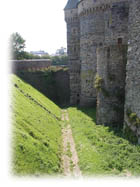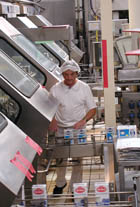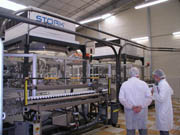
This is the home of Camembert, the LeMans race course, and, in Vitré, one of the largest fluid milk plants in the country. The Groupe Lactalis facility not only produces more than 1.5 million liters of milk, baby formula, and juice daily, but it offers a bit of a history lesson as well, for anyone interested in the dairy industry.
"The very first Tetra Pak machine in France was installed in this plant in Vitré," says Plant Director Christophe Coquel, as he leads Dairy Foods on a plant visit. There are six Tetra Pak lines each producing up to 6,000 liters per hour. The historic Tetra Pak machine now makes its home in the company's Lactopôle Museum in neighboring Laval (see sidebar on page 106).
The six Tetra Pak lines are complemented by four aseptic plastic lines featuring Stork blow molding equipment and Serac fillers with double clean rooms. The fourth of these lines is housed in an expanded footprint of the plant and it came on line in mid-April.
Groupe Lactalis, is the second largest dairy company in France, and the country's number one exporter of dairy products. With more than $7 billion in annual revenue, it is one of the largest dairy processors in the world.

But Lactalis also sells a great deal of milk and cream, industrial dairy products and a very small amount of milk-fed veal.
At the Vitré plant, the product mix is milk, baby formula, organic milk, and small amounts of goats milk and juice.
Focused on Fluid
"When this plant was built in 1968 all French dairy plants were required to produce a full line of products," Coquel says. "But in the 1980s we began to specialize, and the Vitré plant began to focus on fluid milk products."
About 80% of European milk is sold in aseptic, shelf stable packaging. Vitré is 100% UHT aseptic.
"We receive about 17 truck loads of milk per day, or about 1 million liters," Coquel says. "We run round the clock between six and seven days a week and we receive milk every day."
The milk is homogenized, and fat levels are set, then it is pasteurized, and sent for storage in one of nine silos until it is needed, generally for a maximum of 24 to 36 hours. For most products the fat level is set to 1.5%, the European standard of "semi-skim."
When the stored milk is needed for filling it is then UHT treated with a Stork serpentine helicolodial system before being sent to fillers.
Let there be light, or not
The Vitré facility has another feature that's rare in US dairy plants-natural light. Many rooms feature frosted glass skylights that let in a soft, diffused natural light that works in conjunction with the plant lighting. In the newest room, large plate glass windows in the walls provide a view of the French countryside while helping to provide a bright, well-lit work environment.
The individual lines are designed to execute uninterrupted runs of 36 to 48 hours, Coquel says. "Afterward we shut down and do a shift of clean-in-place and maintenance."
The Tetra Pak lines are configured for one-liter baseline bricks and one-liter square top cartons. Liter packages are typically bundled in six packs, or in three packs. Depending on the products, spout fitments may be applied to cartons and handles can be incorporated in the registered photo-printed overwrap used for bundling the multipacks.
On the Serac/Stork side of the Vitré plant, bottles are blown in three or six layers with a base material of white opaque HDPE. Bottles are filled in a variety of sizes ranging from quarter liter to one-liter.
While dairy employees may perform better in a well-lighted facility, dairy products, of course, prefer to be kept in the dark. While UHT milk needs no refrigeration, it may be even more important to protect it from light during its long shelf life. For this reason, a middle layer of carbon black is included as a light barrier in all plastic packages. Some products require protection from oxygen penetration, in which case an additional layer of ethylene vinyl alcohol (EVOH) is used in conjunction with an adhesion layer on either side of it.
For the new line, bottles are blowmolded on two machines, each sporting 14 heads. Each machine can produce 7,000 bottles per hour. All tolled, the plant has 10 blowmolding machines.
With shelf stable products, the integrity of the package is extremely important. Blowmolded bottles are tested for leaks in a vacuum chamber before a Posimat uscrambler directs them into a pneumatic conveying system. Plant personnel also do random sampling for structural integrity and wall thickness.
The four Serac fillers are housed in aseptic chambers within four separate clean rooms. Each has three levels of asepsis, beginning with the outer clean room then an inner chamber and then the filler itself. The clean rooms are fitted with a set of filters which remove progressively smaller particles from the air. Each chamber represents a 10-fold reduction over the previous. The chambers are pressurized with treated air. The most exacting is dioctyl phthalate (DOP) filter that removes any particles of 0.5 microns or larger.
Operators don sterile work clothes before entering the clean rooms.
The Serac fillers are rotary machines with either 24 or 30 heads depending on the line. Each is able to reach a speed of 12,000 to 18,000 bottles per hour.
A foil seal is applied with a pressure/thermal system that heats the top to 220°C for around four seconds. As the bottles leave the filler, they are sent to a sleever and heat tunnel for the application of full shrink sleeves, and then a resealable outer cap is applied.
For the Eveil baby formula line, some of the smallest bottles are fitted with a ready-to-use nipple fitment, for sale as a convenience, on-the-go item.
Warehouse and distribution
As with the paperboard packages, most product configurations are bundled into four or six pack multi-packs and a film outer wrap applied. Some products are put into corrugated cases, but many are sent directly to robotic palletizers which are capable of building case-less pallets. Ten separate palletizers are used.
Product is quarantined for a short period while batch samples are tested.
Baby formula products receive the most scrutiny and are held the longest.
From this warehouse space, UHT milk is sent to more than 50 countries around the world. About 20% of the milk and other fluid products packaged in Vitré are destined for export markets. While the Lactel brand is synonymous with milk in France, Lactalis's President brand is used for most of the products sold internationally. In France, President is reserved for cheese products.
In France, products are distributed to a variety of retail outlet types by a Lactalis fleet.
The Vitré plant has been certified to produce pure organic milk since 1995. Raw milk for the Bio Lactel brand, is stored in dedicated silos and processed and packaged on a dedicated line. The plant also utilizes a HACCP plan, and in order to avoid cross contamination, the product flow throughout the plant is configured so that there is no doubling back or crossover.
This article originally appeared in the October 2004 issue of Dairy Foods.
Plant Facts
Location:Vitré, FranceBuilt: 1968
Recent expansion: Spring 2004
Current Size: 85,000 sq. feet
Number of lines: 10
Daily production: 1.5 million liters
Annual milk production: 350 million packages
Employees: 260
Products: 350
Product types: milk, baby formula, organic milk, goats milk, juice
Lactalis Facts
Headquarters:Laval, FranceFounded: 1933
Ownership: Privately held by the Besnier family
Chief Executive: Michel Léonard
2003 sales: $7.2 billion
Plants: 65 in France, 15 elsewhere
Distribution: About 60% in France, exports to 140 countries
Employees: 16,500
Subsidiary: Sorrento Lactalis, US
Chief Brands: President, Lactel, Bridel, Société, Sorrento
For More Information:
Fillling Equipment:TetraPak,
www.tetrapakusa.com
847/955-6000 (USA)
Serac,
www.serac-group.com.
+33 2 43 60 28 28 (FRA)
Blowmolding equipment:
Stork,
www.stork-usa.com
(770) 535-1875 (USA)
Controls:
Siemens,
www.siemens.com
+49 89 636-00 (GER)
Plastics:
BP Solvay
www.solvay.com
Sanitation:
Ecolab
www.ecolab.com
651/293-2233 (USA)

